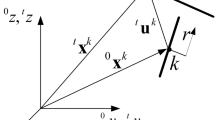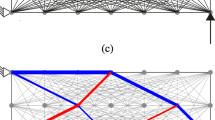Abstract
A two-step topology-finding method based on mixed integer programming and nonlinear programming is proposed for tensegrity structures. In the first step, feasible and symmetric strut connectivities are obtained through a ground structure method combined with mixed integer programming; in the second step, the cable connectivities are optimized through nonlinear programming to obtain a feasible tensegrity structure. The same ground structure used in the first step is adopted in the second step, which is beneficial to find a more symmetric cable layout. The independent continuous mapping method is used in the second step to convert the 0–1 binary variables of cable connectivities to continuous variables to transform the combinatorial optimization problem into a nonlinear programming problem. The number of strut lengths is adopted as a control parameter and a symmetry objective function is proposed to generate a variety of regular and symmetric tensegrity structures. A multi-stage computation scheme is proposed to improve the computational efficiency. Typical examples are carried out to validate the proposed method. The computational efficiency of the method is benchmarked with existing methods fully based on mixed integer programming. Results demonstrate that the computational efficiency of the proposed method is significantly improved compared to the existing methods.













Similar content being viewed by others
References
Bertsekas, D. P. (1997). Nonlinear programming. Journal of the Operational Research Society, 48(3), 334–334.
Bian, W., Chen, X., & Ye, Y. (2014). Complexity analysis of interior point algorithms for non-Lipschitz and nonconvex minimization. Mathematical Programming, 149(1–2), 301–327.
Bovet, D. P., & Crescenzi, P. (1994). Introduction to the Theory of Complexity. Journal of the Operational Research Society 46(12).
Cai, H., Wang, M., Xu, X., et al. (2020). A general model for both shape control and locomotion control of tensegrity systems. Frontiers in Built Environment, 6, 98.
Cai, R., Ren, A., Soundarajan, S., et al. (2018). A low-computation-complexity, energy-efficient, and high-performance linear program solver based on primaldual interior point method using memristor crossbars. Nano Communication Networks, 18, 62–71.
Caluwaerts, K., Despraz, J., Iscen, A., et al. (2014). Design and control of compliant tensegrity robots through simulation and hardware validation. Journal of the Royal Society Interface, 11(98), 20140520.
Cameron, S. (1985). A study of the clash detection problem in robotics. In 2nd IEEE International Conference on Robotics and Automation, ICRA 1985, March 25, 1985 - March 28, 1985. St. Louis, MO, United states: Institute of Electrical and Electronics Engineers Inc., pp. 488–493.
Connelly, R. (2002). Tensegrity structures: Why are they stable? Springer.
Connelly, R., & Terrell, M. (1995). Globally rigid symmetric tensegrities. Structural Topology 21.
Dorn, W., Gomory, R., & Greenberg, H. (1964). Automatic design of optimal structures. Journal of Mechanics, 3(1), 25–52.
Ehara, S., & Kanno, Y. (2010). Topology design of tensegrity structures via mixed integer programming. International Journal of Solids and Structures, 47(5), 571–579.
Fest, E., Shea, K., & Smith, I. F. C. (2004). Active tensegrity structure. Journal of Structural Engineering, 130(10), 1454–1465.
Gan, B. S., Zhang, J., Nguyen, D.-K., et al. (2015). Node-based genetic form-finding of irregular tensegrity structures. Computers and Structures, 159, 61–73.
Geiger, D. H., Stefaniuk, A., & Chen, D. (1986). The design and construction of two cable domes for the Korean Olympics. In Proceedings of the IASS Symposium on Shells, Membranes and Space Frames. pp. 265–272.
González, Á. (2010). Measurement of areas on a sphere using fibonacci and latitude-longitude lattices. Mathematical Geosciences, 42, 49–64.
Graells Rovira, A., & Mirats Tur, J. M. (2009). Control and simulation of a tensegrity-based mobile robot. Robotics and Autonomous Systems, 57(5), 526–535.
Gurobi Optimization L (2021) Gurobi Optimizer Reference Manual.
Ingber, & Donald, E. (1998). The architecture of life. Scientific American, 278(1), 48.
Ingber, D. E. (1997) Tensegrity: The architectural basis of cellular mechanotransduction. In: Hoffman, J.F. (Ed) Annual Review of Physiology. pp. 579–599.
Ingber, D. E., Wang, N., & Stamenovi, D. (2014). Tensegrity, cellular biophysics, and the mechanics of living systems. Reports on Progress in Physics, 77(4), 046603.
Kanno, Y. (2012). Topology optimization of tensegrity structures under self-weight loads. Journal of the Operations Research Society of Japan, 2(2), 125–145.
Kanno, Y. (2013). Exploring new tensegrity structures via mixed integer programming. Structural and Multidisciplinary Optimization, 48(1), 95–114.
Lawler, E. L., & Wood, D. E. (1966). Branch-and-bound methods—A survey. Operations Research, 14(4), 699.
Lee, S., & Lee, J. (2016). A novel method for topology design of tensegrity structures. Composite Structures, 152, 11–19.
Liu, K., & Paulino, G. H. (2019). Tensegrity topology optimization by force maximization on arbitrary ground structures. Structural and Multidisciplinary Optimization, 59(6), 2041–2062.
Lofberg, J. (2004). YALMIP: A toolbox for modeling and optimization in MATLAB. In 2004 IEEE International Symposium on Computer Aided Control System Design, September 2, 2004 - September 4, 2004. Taipei, Taiwan: Institute of Electrical and Electronics Engineers Inc., pp. 284–289.
Lu, Y., Xu, X., & Luo, Y. (2019). Path planning for rolling locomotion of polyhedral tensegrity robots based on Dijkstra algorithm. Journal of the International Association for Shell and Spatial Structures, 60(4), 273–286.
MathWorks, Inc. T (2021) MATLAB help document. http://cn.mathworks.com/. Retrieved May 28.
Motro, R. (2003). Tensegrity: Structural systems for the future. Elsevier Ltd.
Murakami, H., & Nishimura, Y. (2001). Static and dynamic characterization of regular truncated icosahedral and dodecahedral tensegrity modules. International Journal of Solids and Structures, 38(50–51), 9359–9381.
Myers, T. W. (2020). Tension-dependent structures in a stretch-activated system. Journal of Bodywork and Movement Therapies, 24(1), 131–133.
Pandian, N. K. R., & Ananthasuresh, G. K. (2017). Synthesis of tensegrity structures of desired shape using constrained minimization. Structural and Multidisciplinary Optimization, 56(6), 1233–1245.
Paul, C., Lipson, H., & Cuevas, F.J.V. (2005). Evolutionary form-finding of tensegrity structures. In: GECCO 2005 - Genetic and Evolutionary Computation Conference, June 25, 2005 - June 29, 2005. Washington, D.C., United states: Association for Computing Machinery, pp. 3–10.
Paul, C., Valero-Cuevas, F. J., & Lipson, H. (2006). Design and control of tensegrity robots for locomotion. IEEE Transactions on Robotics, 22(5), 944–957.
Pelegrino, S., & Calladine, C. R. (1986). Matrix analysis of statically and kinematically indeterminate frameworks. International Journal of Solids and Structures, 22(4), 409–428.
Sabelhaus, A. P., Bruce, J., Caluwaerts, K. et al. (2015). System design and locomotion of SUPERball, an untethered tensegrity robot. In: 2015 IEEE International Conference on Robotics and Automation, ICRA 2015, May 26, 2015 - May 30, 2015. June ed. Seattle, WA, United states: Institute of Electrical and Electronics Engineers Inc., pp. 2867–2873.
Snelson, K. (2012). The art of tensegrity. International Journal of Space Structures, 27(2–3), 71–80.
Sui, Y.-K., & Ye, H.-L. (2013). Continuum topology optimization methods ICM. Science Press.
Sui, Y.-K., Ye, H.-L., Liu, J.-X., et al. (2008). A structural topological optimization method based on exploring conceptual root. Gongcheng Lixue/engineering Mechanics, 25(SUPPL. 2), 7–19.
Sui, Y. K., & Yang, D. Q. (1998). A new method for structural topological optimization based on the concept of independent continuous variables and smooth model. Acta Mechanica Sinica, 14(2), 179–185.
Tadeo, I., Berbegall, A. P., Escudero, L. M., et al. (2014). Biotensegrity of the extracellular matrix: Physiology, dynamic mechanical balance, and implications in oncology and mechanotherapy. Frontiers in Oncology, 4, 39–39.
Tibert, A. G., & Pellegrino, S. (2003). Review of form-finding methods for tensegrity structures. International Journal of Space Structures, 18(4), 209–223.
Wang, Y., Xu, X., & Luo, Y. (2020). Topology design of general tensegrity with rigid bodies. International Journal of Solids and Structures, 202, 278–298.
Xu, X., & Luo, Y. (2010). Force finding of tensegrity systems using simulated annealing algorithm. Journal of Structural Engineering, 136(8), 1027–1031.
Xu, X., Sun, F., Luo, Y., et al. (2014). Collision-free path planning of tensegrity structures. Journal of Structural Engineering, 140(4), 04013084.
Xu, X., Wang, Y., & Luo, Y. (2016). General approach for topology-finding of tensegrity structures. Journal of Structural Engineering, 142(10), 04016061.
Xu, X., Wang, Y., Luo, Y., et al. (2018). Topology optimization of tensegrity structures considering buckling constraints. Journal of Structural Engineering, 144(10), 04013084.
Zhang, J. Y., & Ohsaki, M. (2007). Stability conditions for tensegrity structures. International Journal of Solids and Structures, 44(11–12), 3875–3886.
Zhang, X., Ramos, A. S., & Paulino, G. H. (2017). Material nonlinear topology optimization using the ground structure method with a discrete filtering scheme. Structural and Multidisciplinary Optimization, 55(6), 2045–2072.
Acknowledgements
This work was supported by the National Natural Science Foundation of China (Grant No. 52178175, 52108182), grant from Center for Balance Architecture of Zhejiang University, China Postdoctoral Science Foundation (Grant No. 2021M702867), and funding for postdoctoral research projects of Zhejiang Province (Grant No. ZJ2021009).
Author information
Authors and Affiliations
Corresponding author
Ethics declarations
Conflict of interest
The authors declare that they have no known competing financial interests or personal relationships that could have appeared to influence the work reported in this paper.
Additional information
Publisher's Note
Springer Nature remains neutral with regard to jurisdictional claims in published maps and institutional affiliations.
Rights and permissions
About this article
Cite this article
Xu, X., Huang, S., Shu, T. et al. A Novel Two-Step Tensegrity Topology-Finding Method Based on Mixed Integer Programming and Nonlinear Programming. Int J Steel Struct 22, 1266–1282 (2022). https://doi.org/10.1007/s13296-022-00634-x
Received:
Accepted:
Published:
Issue Date:
DOI: https://doi.org/10.1007/s13296-022-00634-x




